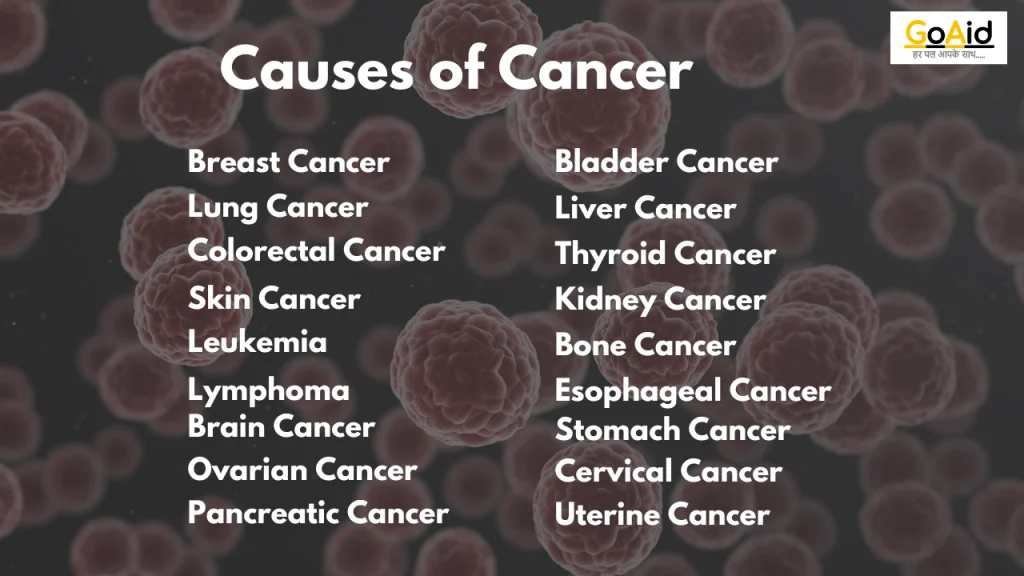In India, there are more than 25 lakh cancer patients of the cancer. Now this number is indeed scary. This is why, knowing all the details of cancer is important for us. Also, there are many symptoms that individuals look for themselves but canŌĆÖt recognize that they are affected by cancer.
This is why, in this detailed blog, we have added all the details about ŌĆśWhat is Cancer?ŌĆÖ not only that, but we have also added a complete set of details entailing about the symptoms, causes, types, and almost everything about cancer. If you are also looking for this detail, then read our blog to the very end.
So, letŌĆÖs start:
Full Details about the Cancer
Cancer in India is a growing concern for all those who are patients of cancer or those who are going to be the patients of cancer. India is facing an alarming rise in cases & earning it the label of ŌĆ£the cancer capital of the world.ŌĆØ
Many factors contribute to this surge including advancing age, unhealthy diets, air pollution, and exposure to carcinogens. Breast, cervix, and ovarian cancers affect women, while lung, mouth, and prostate cancers are common among men.
By 2025, annual cancer cases are projected to reach 1.57 million. Early detection and awareness are crucial in managing this health challenge. You can have a comprehensive detail about Cancer in the blog below:
What is Cancer?
We can understand Cancer in a manner that it is a complex group of diseases that is characterized by abnormal cell growth that spreads uncontrollably. It often causes damage to surrounding tissues. It can develop virtually anywhere in the body and manifests in various forms.
Each of these forms can be recognized with distinct characteristics and treatment approaches. The underlying causes of cancer are multifactorial, including genetic predisposition, environmental factors like tobacco use and exposure to carcinogens, and lifestyle choices such as diet and physical activity.
While advancements in research and treatment have improved outcomes, cancer remains a significant global health challenge, demanding ongoing efforts in prevention, early detection, and innovative therapies to mitigate its impact.
Different Types of Cancer
As we mentioned before, cancer can be generated or formed in any part of the body and can be in any form. This is why; there are so many types of cancer:
| S.No. | Types | S.No. | Types |
| 1 | Lung Cancer | 17 | Breast Cancer |
| 2 | Prostate Cancer | 18 | Cervical Cancer |
| 3 | Colorectal Cancer | 19 | Uterine Cancer |
| 4 | Skin Cancer | 20 | Testicular Cancer |
| 5 | Leukemia | 21 | Sarcoma |
| 6 | Lymphoma | 22 | Melanoma (a type of skin cancer) |
| 7 | Brain Cancer | 23 | Multiple Myeloma |
| 8 | Ovarian Cancer | 24 | Mesothelioma |
| 9 | Pancreatic Cancer | 25 | Head and Neck Cancers |
| 10 | Bladder Cancer | 26 | Gallbladder Cancer |
| 11 | Liver Cancer | 27 | Eye Cancer (such as retinoblastoma) |
| 12 | Thyroid Cancer | 28 | Neuroendocrine Tumors |
| 13 | Kidney Cancer | 29 | Adrenal Cancer |
| 14 | Bone Cancer | 30 | Carcinoid Tumors |
| 15 | Esophageal Cancer | 31 | Thymoma and Thymic Carcinoma |
| 16 | Stomach Cancer | 32 | Merkel Cell Carcinoma |
Classification of Cancer
We can classify the Cancer in 10 classifications:
- Carcinomas: Cancers that begin in the skin or in tissues that line or cover internal organs. Subtypes include:
- Adenocarcinoma
- Basal cell carcinoma
- Squamous cell carcinoma
- Transitional cell carcinoma
- Sarcomas: Cancers that begin in the bone, cartilage, fat, muscle, blood vessels, or other connective or supportive tissue.
- Leukemias: Cancers that start in blood-forming tissue such as the bone marrow and cause large numbers of abnormal blood cells to be produced and enter the bloodstream.
- Lymphomas: Cancers that begin in the cells of the immune system. The main types are:
- Hodgkin lymphoma
- Non-Hodgkin lymphoma
- Multiple Myeloma: Cancer that begins in the plasma cells, a type of white blood cell.
- Melanoma: Cancer that begins in the cells that become melanocytes, which are specialized cells that produce melanin (the pigment that gives skin its color).
- Brain and Spinal Cord Tumors: Cancers that begin in the central nervous system. They are classified based on the cell of origin, such as:
- Gliomas
- Meningiomas
- Germ Cell Tumors: Cancers that begin in the cells that give rise to sperm or eggs. These can occur in the ovaries or testicles, and sometimes in other areas of the body.
- Neuroendocrine Tumors: Cancers that begin in neuroendocrine cells, which have traits of both hormone-producing cells and nerve cells. Examples include: Carcinoid tumors
- Carcinosarcomas: Cancers that contain features of both carcinomas and sarcomas.
Each type can be further classified based on specific characteristics of the cells and their behavior.
Symptoms of Cancer
As we added before there are so many types of cancer. Writing the symptoms of all of these can be hectic and reading them may be a headache, this is why, we have added the details with symptoms of the 20 most common cancers:
| S. No. | Symptoms | Description |
| 1. | Breast Cancer | Breast cancer originates in the cells of the breast, often in the ducts or lobules. It can spread to other parts of the body. |
| 2 | Lung Cancer | Lung cancer starts in the lungs, usually in the cells lining the air passages. It can be non-small cell or small cell lung cancer. |
| 3 | Prostate Cancer | Prostate cancer develops in the prostate gland in men, often growing slowly but can spread to other parts of the body. |
| 4 | Colorectal Cancer | Colorectal cancer begins in the colon or rectum. It often starts as benign polyps that can become cancerous over time. |
| 5 | Skin Cancer | Skin cancer arises from the skin cells, with common types including basal cell carcinoma, squamous cell carcinoma, and melanoma. |
| 6 | Leukemia | Leukemia is a cancer of the blood-forming tissues, leading to the production of abnormal white blood cells. It affects the bone marrow and blood. |
| 7 | Lymphoma | Lymphoma is a cancer of the lymphatic system, which includes lymph nodes, spleen, and bone marrow. The main types are Hodgkin and non-Hodgkin lymphoma. |
| 8 | Brain Cancer | Brain cancer originates in the brain cells. It can be benign or malignant and may affect cognitive and physical functions. |
| 9 | Ovarian Cancer | Ovarian cancer begins in the ovaries. It is often detected at a later stage due to subtle early symptoms. |
| 10 | Pancreatic Cancer | Pancreatic cancer starts in the tissues of the pancreas. It often goes undetected until advanced stages. |
| 11 | Bladder Cancer | Bladder cancer starts in the cells lining the bladder. It often presents with urinary symptoms and can spread to other areas. |
| 12 | Liver Cancer | Liver cancer originates in the liver cells, commonly hepatocellular carcinoma. It is often linked to liver cirrhosis and hepatitis. |
| 13 | Thyroid Cancer | Thyroid cancer begins in the thyroid gland, affecting its hormone-producing capabilities. It often has a high treatment success rate. |
| 14 | Kidney Cancer | Kidney cancer originates in the kidney cells, with renal cell carcinoma being the most common type. It may not show early symptoms. |
| 15 | Bone Cancer | Bone cancer starts in the bone cells. It can be primary (originating in the bone) or secondary (spread from other areas). |
| 16 | Esophageal Cancer | Esophageal cancer begins in the lining of the esophagus. It can be squamous cell carcinoma or adenocarcinoma. |
| 17 | Stomach Cancer | Stomach cancer, or gastric cancer, starts in the stomach lining. It often progresses without early symptoms. |
| 18 | Cervical Cancer | Cervical cancer begins in the cervix, often linked to human papillomavirus (HPV) infection. It can be detected early through screening. |
| 19 | Uterine Cancer | Uterine cancer starts in the lining of the uterus (endometrium). It is most common in postmenopausal women. |
| 20 | Testicular Cancer | Testicular cancer begins in the testicles, typically affecting younger men. It often has a high treatment success rate. |
Causes of Cancer

We have added all the details about the causes of all these most common types of cancer:
1. Breast Cancer
Causes: Genetic mutations (BRCA1 and BRCA2), family history, age, hormone replacement therapy, early menstruation, late menopause, obesity, and alcohol consumption.
2. Lung Cancer
Causes: Smoking, exposure to secondhand smoke, exposure to radon gas, asbestos, air pollution, family history, and certain genetic mutations.
3. Prostate Cancer
Causes: Age, family history, genetic factors, diet high in red meat and dairy, obesity, ethnicity (higher risk in African American men).
4. Colorectal Cancer
Causes: Genetic mutations (e.g., Lynch syndrome, FAP), family history, inflammatory bowel disease, high-fat diet, low fiber intake, obesity, smoking, alcohol consumption.
5. Skin Cancer
Causes: Excessive sun exposure, tanning beds, fair skin, family history, certain genetic conditions, immune suppression, exposure to certain chemicals.
6. Leukemia
Causes: Genetic mutations, exposure to radiation or certain chemicals, family history, smoking, certain genetic disorders (e.g., Down syndrome), previous chemotherapy.
7. Lymphoma
Causes: Weakened immune system, certain infections (e.g., Epstein-Barr virus, HIV), family history, exposure to certain chemicals, genetic mutations.
8. Brain Cancer
Causes: Genetic mutations, family history, exposure to high doses of ionizing radiation, certain inherited syndromes (e.g., neurofibromatosis), and age.
9. Ovarian Cancer
Causes: Genetic mutations (BRCA1 and BRCA2), family history, age, hormone replacement therapy, never having been pregnant, endometriosis.
10. Pancreatic Cancer
Causes: Genetic mutations, family history, smoking, obesity, chronic pancreatitis, diabetes, age.
11. Bladder Cancer
Causes: Smoking, exposure to certain chemicals (e.g., in the dye industry), chronic bladder infections, age, family history, and previous radiation therapy.
12. Liver Cancer
Causes: Chronic hepatitis B or C infection, cirrhosis, heavy alcohol use, nonalcoholic fatty liver disease, aflatoxin exposure, smoking, obesity.
13. Thyroid Cancer
Causes: Genetic mutations, family history, radiation exposure, certain inherited conditions (e.g., MEN2), female sex, age.
14. Kidney Cancer
Causes: Smoking, obesity, high blood pressure, family history, certain genetic syndromes (e.g., von Hippel-Lindau), long-term dialysis, and exposure to certain chemicals.
15. Bone Cancer
Causes: Genetic mutations, previous radiation therapy, certain genetic disorders (e.g., Li-Fraumeni syndrome), Paget’s disease of bone, and age.
16. Esophageal Cancer
Causes: Smoking, heavy alcohol consumption, gastroesophageal reflux disease (GERD), Barrett’s esophagus, obesity, diet low in fruits and vegetables, age.
17. Stomach Cancer
Causes: Helicobacter pylori infection, diet high in smoked and salted foods, smoking, family history, previous stomach surgery, certain genetic conditions, age.
18. Cervical Cancer
Causes: Human papillomavirus (HPV) infection, smoking, weakened immune system, long-term use of birth control pills, multiple pregnancies, family history.
19. Uterine Cancer
Causes: Hormonal imbalances, obesity, age, never having been pregnant, early menstruation or late menopause, hormone replacement therapy, family history.
20. Testicular Cancer
Causes: Undescended testicle, family history, previous testicular cancer, age (younger men), ethnicity (higher risk in Caucasian men), and certain genetic conditions.
Treatment of Cancer
Cancer treatment varies depending on the type, stage, and location of the cancer, as well as the overall health of the patient. Here are common treatment options:
Surgery
- Description: Surgical removal of the tumor and surrounding tissue. It’s often used for solid tumors that are localized and have not spread.
- Use: Common in breast, prostate, lung, colorectal, skin, and many other types of cancer.
Radiation Therapy
- Description: Uses high doses of radiation to kill cancer cells or shrink tumors. It can be external beam radiation or brachytherapy (internal radiation).
- Use: Effective for many cancers, including breast, prostate, brain, and head and neck cancers.
Chemotherapy
- Description: Uses drugs to kill cancer cells or stop their growth. Chemotherapy can be systemic (affecting the whole body) or localized.
- Use: Used for a wide range of cancers, including leukemia, lymphoma, breast, lung, and ovarian cancers.
Immunotherapy
- Description: Boosts or modifies the immune system to fight cancer. This includes checkpoint inhibitors, CAR T-cell therapy, and cancer vaccines.
- Use: Effective for melanoma, lung cancer, bladder cancer, and certain types of lymphoma and leukemia.
Targeted Therapy
- Description: Uses drugs that target specific molecules involved in cancer cell growth and survival. This includes monoclonal antibodies and small molecule inhibitors.
- Use: Used for cancers with specific genetic mutations, such as breast cancer (HER2-positive), lung cancer (EGFR mutations), and chronic myeloid leukemia.
Hormone Therapy
- Description: Blocks or lowers the amount of hormones in the body to slow or stop cancer growth. Commonly used for hormone-sensitive cancers.
- Use: Effective for breast cancer (ER-positive) and prostate cancer.
Stem Cell Transplant
- Description: Replaces damaged bone marrow with healthy stem cells. This can be autologous (using the patientŌĆÖs cells) or allogeneic (from a donor).
- Use: Used primarily for blood cancers like leukemia, lymphoma, and multiple myeloma.
Precision Medicine
- Description: Tailors treatment based on the genetic profile of the cancer. It involves genetic testing to identify specific mutations and select targeted treatments.
- Use: Applied to various cancers with identifiable genetic markers.
Palliative Care
- Description: Focuses on relieving symptoms and improving the quality of life for patients with serious illness. It can be used alongside curative treatments.
- Use: Important for managing symptoms in advanced cancers and improving patient comfort.
Clinical Trials
- Description: Research studies that test new treatments or new ways of using existing treatments. Participation can provide access to cutting-edge therapies.
- Use: Available for all types and stages of cancer, offering potential new options when standard treatments are not effective.
Cost of Cancer Treatment in India
Here is a brief overview of the approximate costs of each type of cancer treatment, though it’s important to note that these costs can vary widely based on the specific type of cancer, the stage, location, healthcare provider, and region:
| S. No. | Cancer Treatment | Cost |
| 1. | Surgery | Apx: 12,30,000 – 41,00,000 |
| 2. | Radiation Therapy | Apx: 8,20,000 – 41,00,000 |
| 3. | Chemotherapy | Apx: 8,20,000 – 82,00,000 |
| 4. | Immunotherapy | Apx: 41,00,000 – 1,64,00,000 |
| 5. | Targeted Therapy | Apx: 8,20,000 – 82,00,000 |
| 6. | Hormone Therapy | Apx: 8,20,000 – 16,40,000 |
| 7. | Stem Cell Transplant | Apx: 82,00,000 – 2,46,00,000 |
| 8. | Precision Medicine | Apx: 16,40,000 – 82,00,000 |
| 9. | Palliative Care | Apx; 41,000 – 4,10,000 |
| 10. | Clinical Trials | Often free or covered by sponsors |
The thing we need to Consider Before Cancer Treatment
These are some focused things we always need to consider before any type of cancer treatment:
1. Molecular Profiling
- Importance: Molecular profiling of your tumor can identify specific genetic mutations or biomarkers that can influence treatment decisions. This personalized approach can help determine the most effective targeted therapies.
- Action: Discuss the possibility of molecular profiling with your oncologist and ensure it is part of your diagnostic workup.
2. Immunotherapy Eligibility
- Importance: Not all patients are eligible for immunotherapy. Specific biomarkers, such as PD-L1 expression, can determine whether you might benefit from this treatment.
- Action: Request testing for relevant biomarkers to assess your suitability for immunotherapy.
3. Clinical Trials
- Importance: Clinical trials can provide access to cutting-edge treatments that are not yet widely available. Participating in a trial may offer additional options if standard treatments are not suitable.
- Action: Ask your doctor about ongoing clinical trials that match your cancer type and stage, and consider enrolling if appropriate.
4. Pharmacogenomics
- Importance: Pharmacogenomic testing can predict how you will respond to certain chemotherapy drugs based on your genetic makeup. This helps tailor the drug choice and dosage to minimize side effects and maximize efficacy.
- Action: Inquire about pharmacogenomic testing to personalize your chemotherapy regimen.
5. Radiation Planning and Dosimetry
- Importance: Advanced radiation planning techniques like intensity-modulated radiation therapy (IMRT) or proton therapy can target tumors more precisely while sparing healthy tissue.
- Action: Discuss with your radiation oncologist the use of advanced planning techniques and ensure dosimetry is optimized for your treatment.
6. Nutritional Support
- Importance: Cancer treatments can significantly impact nutritional status. Pre-treatment nutritional assessments and ongoing support can help maintain strength and improve treatment outcomes.
- Action: Consult with a registered dietitian specializing in oncology to develop a nutrition plan tailored to your needs.
7. Cardiotoxicity Assessment
- Importance: Some cancer treatments, especially certain chemotherapies and targeted therapies, can affect heart function. Baseline cardiac assessments and ongoing monitoring are crucial.
- Action: Have a cardiologist evaluate your heart health before starting treatment, especially if you have a history of cardiovascular issues.
8. Fertility Preservation
- Importance: Certain cancer treatments can affect fertility. Options for preserving fertility, such as sperm banking or egg freezing, should be considered before treatment begins.
- Action: Discuss fertility preservation with a specialist and take appropriate steps if you wish to have children in the future.
9. Infection Risk Management
- Importance: Chemotherapy and other treatments can weaken the immune system, increasing infection risk. Pre-treatment assessments and prophylactic measures are essential.
- Action: Ensure vaccinations are up-to-date and discuss prophylactic antibiotics or antifungals with your oncologist if you’re at high risk for infections.
10. Bone Health Monitoring
- Importance: Treatments like hormone therapy and steroids can impact bone density. Baseline bone density scans and interventions to prevent osteoporosis may be needed.
- Action: Get a baseline bone density scan and discuss bone health management strategies, including supplements and lifestyle changes, with your healthcare provider.
Top 10 Best Hospitals for Cancer Treatment in Delhi
These are the DelhiŌĆÖs most famous & Top 10 Best Cancer Hospitals in Delhi:
- All India Institute of Medical Sciences (AIIMS)
- Indraprastha Apollo Hospital
- Rajiv Gandhi Cancer Institute and Research Center (RGCIRC)
- Max Super Speciality Hospital, Saket
- Fortis Memorial Research Institute
- Dharamshila Narayana Superspeciality Hospital
- Sir Gangaram Hospital
- BLK Super Speciality Hospital
- Artemis Hospital
- Moolchand Hospital
If you want to know more detailed information about these hospitals, then you can read our this blog:
Top 10 Best Hospitals for Cancer Treatment in Delhi
10 Key Facts about Cancer
These are the 10 key facts or we can say the Interesting facts about cancer:
- Ancient Disease: Cancer has been found in the bones of Egyptian mummies, indicating it has been affecting humans for thousands of years. The first recorded case dates back to around 1500 B.C.
- Personalized Vaccines: Researchers are developing personalized cancer vaccines that train the immune system to recognize and attack specific mutations in a patient’s tumor.
- Elephants and Cancer Resistance: Elephants have 20 copies of the p53 gene, a powerful cancer-fighting gene, compared to humans who have only one. Despite their large size and long lifespan, this contributes to their lower cancer rates.
- Cancer-Fighting Plants: The rosy periwinkle, a plant from Madagascar, produces compounds used to treat leukemia and lymphoma. Its discovery revolutionized cancer treatment in the 20th century.
- Liquid Biopsies: Liquid biopsies, which analyze cancer-related DNA in the blood, are emerging as a non-invasive way to detect cancer early and monitor treatment response.
- Cancer Cells and Sugar: Cancer cells consume glucose at a much higher rate than normal cells, a phenomenon known as the Warburg effect. This is being explored for potential diagnostic and treatment strategies.
- Immunotherapy Breakthroughs: The development of immune checkpoint inhibitors, which “release the brakes” on the immune system, has led to remarkable successes in treating cancers like melanoma and lung cancer.
- Dogs Can Sniff Out Cancer: Trained dogs can detect cancer in humans by smelling their breath, urine, or blood, sometimes even before symptoms appear.
- Survival Rates Soar for Some Cancers: The survival rate for childhood leukemia has increased from less than 10% in the 1960s to over 90% today, thanks to advances in treatment.
- Cancer Research Funding: The U.S. National Cancer Institute (NCI) has an annual budget of over $6 billion for cancer research, fueling continuous advancements in understanding and treating the disease.
Read More: Top 10 Cancer Hospitals in Jaipur
Conclusion
In Conclusion, cancer is a complex group of diseases characterized by the uncontrolled growth and spread of abnormal cells. These cells can invade nearby tissues and organs, potentially spreading to distant parts of the body through the bloodstream or lymphatic system. There are over 100 types of cancer, each with its unique symptoms, causes, and treatment options.
Common causes include genetic mutations, lifestyle factors like smoking and diet, and environmental exposures such as radiation and chemicals. Symptoms vary widely but often include unusual lumps, unexplained weight loss, persistent pain, and changes in bodily functions. Treatments range from surgery and radiation to chemotherapy, immunotherapy, and targeted therapies.
Early detection and prevention through lifestyle changes significantly improve outcomes. We’ve provided comprehensive details on cancer types, causes, symptoms, and treatments, along with key facts. If you have any questions, feel free to ask in the comment box.
Common signs and symptoms of cancer can include unexplained weight loss, persistent fatigue, pain, skin changes, lumps or swelling, persistent cough or hoarseness, changes in bowel or bladder habits, and unusual bleeding or discharge. It’s important to note that these symptoms can also be caused by conditions other than cancer. If you experience any persistent or unusual symptoms, consult with a healthcare provider for a proper evaluation.
Risk factors for cancer include genetic mutations, family history of cancer, age, lifestyle factors such as smoking, alcohol consumption, poor diet, lack of physical activity, exposure to radiation and certain chemicals, chronic infections (e.g., HPV, hepatitis B and C), and certain medical conditions. Reducing exposure to these risk factors can help lower the risk of developing cancer.
Cancer diagnosis typically involves a combination of methods including physical examinations, imaging tests (such as X-rays, CT scans, MRI, and PET scans), laboratory tests (blood, urine, and other body fluids), biopsy (removal of a tissue sample for microscopic examination), and genetic tests. The specific tests depend on the type and location of the suspected cancer.
Treatment options for cancer patients include surgery, radiation therapy, chemotherapy, immunotherapy, targeted therapy, hormone therapy, stem cell transplant, precision medicine, and palliative care. The choice of treatment depends on the type of cancer, its stage, the patient’s overall health, and other factors. Often, a combination of treatments is used to achieve the best outcome.
Generally, not all cancers can be prevented, many can be reduced by making healthy lifestyle choices. These include avoiding tobacco use, limiting alcohol consumption, maintaining a healthy diet rich in fruits and vegetables, engaging in regular physical activity, protecting skin from excessive sun exposure, vaccinating against cancer-related infections (such as HPV and hepatitis B), and participating in regular cancer screenings. Early detection and lifestyle modifications can significantly reduce the risk of developing certain types of cancer.
















